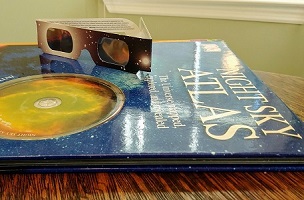The Great American Eclipse
August 19, 2017
August 21, 2017; an auspicious date. Spanning the United States from coast to coast, the moon will cast a shadow and block out the sun. The last such celestial event-an eclipse crossing the USA-was June 8, 1918.
“Eclipse simply means something is going in front of something else,” said Mrs. Lois Stratton, the Bob Jones astronomy teacher, “if you have a solar eclipse, the moon is going in front of the sun. […] Solar eclipses don’t happen very often because they cast a very narrow shadow on the earth.”
Around 1:30 PM, the moon’s blackest shadow will pass over Nashville, and a slightly lighter shade over Madison as the sun’s light is 97 percent blocked. Animals will make noise, confused, as day turns into night.

If you are traveling to the path of totality, you’ll want both a pair of eclipse glasses and a sky atlas–for a few brief seconds the stars will be visible.
A large segment of the nation’s population is converging on the path of totality, spanning the states Oregon, Idaho, Wyoming, Montana, Nebraska, Iowa, Kansas, Missouri, Illinois, Kentucky, Tennessee, Georgia, and North and South Carolina. Interesting locations like Carhenge and the Corvette Museum are expecting double their normal traffic, and hotels in towns across these states have hit capacity.
“I am very excited for Monday,” Mrs. Stratton says, “I’ll be in Nashville.”
Local Events
Most school systems in the area are planning something special for the event.
Madison City Schools will be following the half-day schedule, for reasons explained by Superintendent Robby Parker. “This is not a decision I’ve made lightly. In the interest of safety for our students and affording them an opportunity to experience this unusual natural phenomenon outside the structured environment of a school campus, I felt it best to release schools early,” said the superintendent in an August 10 email, “there is no way we can ensure that glasses used by the student are safe.”
Several sets of eclipse glasses available for purchase have been found unsafe for solar viewing by one of the nation’s only accredited solar glasses testing institutions.
“True solar eclipse glasses are made for adults, do not fit children well and should not be used without direct parental supervision. If the solar glasses do not filter out 100% of the harmful UV rays, if they are not used absolutely perfectly, or should there be a manufacturing defect in any of them, this will result in permanent and irreversible vision loss for any eye exposed. Just like sunburn to the skin, the effects are not felt or noticed immediately. I have a great fear that I will have patients in my office on Tuesday, Aug 22 who woke up with hazy, blurry vision that I cannot fix. It is a huge risk to watch the eclipse even with the use of solar glasses. There is no absolutely safe way to do so other than on TV,” says Dr. Michael Schecter, an optometrist, in a widely circulated social media post.
Superintendent Parker said: “We have no way of ensuring your child’s eyes will not be damaged. I am not willing to take the chance of “hoping” all glasses brought in by the student or acquired by different schools by different staff members from different sites are all 100% safe. […] We cannot offer the opportunity to watch the eclipse to all of our 10,500 students. Some students will get the opportunity and others will not. We do not have 10,500 pairs of glasses.”
With students free for the afternoon’s viewing, many local institutions are holding events. The US Space and Rocket Center will be having an eclipse viewing party in the Davidson Center.
Even in the school building, eclipse fever has affected students and teachers. Many English classes and electives are doing eclipse-related projects: Multimedia Design has been creating Eclipse Safety PSAs, and Mr. Campbell’s Myth and Legend Class is creating a collaborative sonnet on eclipse myths through history, just to name a few. One of the science teachers created a widely-shared rap video about the impending event. During Patriot Path, teachers Nicole Murray and Sheila Hadden hosted an eclipse party, and an eclipse panel was held in Patriot Hall. The volleyball team even had a fundraiser, selling eclipse glasses for $10.
Safe Viewing
Many shipments of eclipse glasses to local stores have sold out. The Huntsville-Madison County Public Library had been giving them away, but ran out due to popular demand. The Parkway Place Mall ran a similar promotion. There are still some shipments of safe glasses available on Amazon, but they are expected to sell out.
Even without eclipse glasses, it is still possible to safely view the sun. A postcard with a pinhole poked in it will broadcast the sun’s light in a safe manner, though onto the ground and not directly into the eye.
“So you want to view the Solar Eclipse, but you don’t have safety glasses. But, you are an American and you live in Alabama, and you NEED to experience this once in a lifetime moment. I have the solution: an Alabama- and USA-shaped pinhole camera template. Simply print this onto cardstock (preferred) or regular copy paper. Cut it out, especially the hole in the middle. During the eclipse, hold the pinhole template out in front of you and let the Sun cast the template’s shadow on the ground. You can then safely view the eclipse without safety glasses,” said Mr. Jeremy Raper, the AP Physics teacher who provided these templates by NASA.
Various designs of home-build eclipse viewers are also safe and easy to build, such as a simple one out of a cardboard box.
The solar eclipse can also be photographed, but it is recommended that a special solar filter is used at any other point in time than the path of totality. The sun’s light can still wreck a camera.
Alternatively, NASA and NOAA are both running live-view digital eclipse-watching. NASA has also developed an app for the event.
Miss the August 21 solar eclipse? The next one in the United States will be April 8, 2024.


